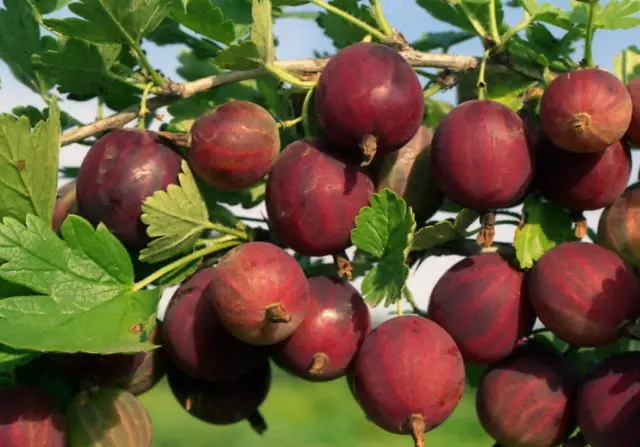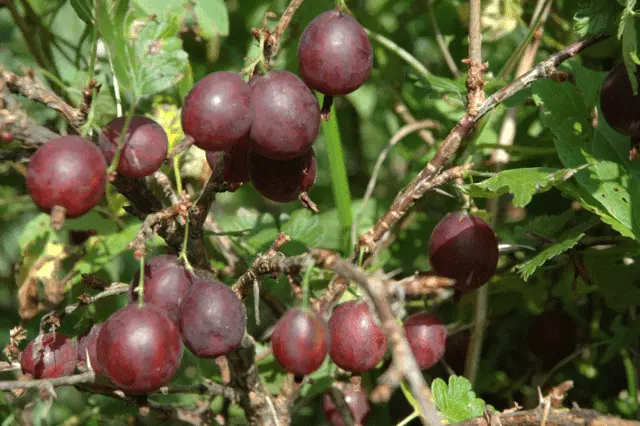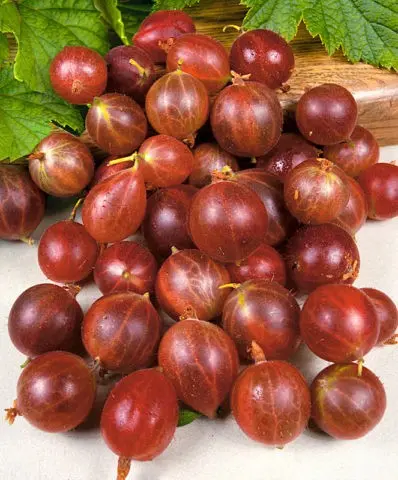Contents
Gooseberry Olavi, or Hinnonomainen Punainen, is a high-yielding Finnish berry variety characterized by a pleasant fruit taste, resistance to parasites and ease of cultivation. Due to its high frost resistance, the culture feels great even in the harsh climatic conditions of the northern and northwestern regions of Our Country. However, before acquiring a gooseberry popular among gardeners, it is worth studying its characteristics, strengths and weaknesses, planting and care features in order to achieve the maximum yield of the variety.

Description of gooseberry Olavi
Gooseberry Olavi (a description of the variety and a photo are given below) has been listed in the State Register of Breeding Achievements since 1999. The shrub is approved for breeding in the Vologda, Tver, Yaroslavl, Kostroma, Kaliningrad, Pskov, Leningrad, Novgorod, Murmansk and Arkhangelsk regions of Our Country. Promising for cultivation throughout the Non-Chernozem zone. It is considered a universal medium-late culture.

Olavi has the following characteristics:
- Bush shape. Weakly sprawling, medium height.
- Run away. Medium thickness, upright, hairless, green. After lignification, they may turn gray.
- The degree of thorniness of the branches is strong. The spines are one- and two-parted, sharp, of medium length and short. They are located along the entire branch and directed perpendicular to it.
- Kidneys. Pointed, small, elongated, slightly deviated.
- The leaf plate is medium in size, hairless, slightly shiny, rich green in color, divided into 3-5 lobes with large teeth along the edges. It is attached to the shoot obliquely with the help of a short cutting.
- The flowers are broadly bell-shaped, of medium size.
- The fruits are medium, weighing about 3,7 g (2,0-4,4 g), rich cherry color, hairless, oval and round, covered with a wax coating.
Variety Olavi is considered a highly self-fertile crop (about 50%) and does not need pollinators.
Drought resistance, frost resistance
Variety Olavi was specially created for growing in areas with long frosty winters and short summers. Culture safely withstands up to -30 ⁰С.
To droughts, the variety Olavi has an average resistance. A long absence of moisture adversely affects the berries. Gooseberries grow small, sluggish and sour in taste. The leaf plates of the shrub turn yellow and slow down growth.
fruiting, productivity
Olavi berries are characterized by:
- juicy sweet and sour pulp (taster score – 4,5);
- almost complete lack of aroma;
- refreshing taste;
- thin skin;
- high productivity (up to 13 kg per bush);
- mid-late ripening (from mid-August – until the frost);
- good keeping quality and transportability.

The chemical composition of gooseberry Olavi in terms of sugar content is in the range of 5,9-11,9%, and in terms of acidity ─ 2,5-3,6%. The amount of ascorbic acid per 100 g of fruits of this variety is 20-39 mg.
Olavi berries are used to make original jams, marmalades, fragrant compote. The fruits are also suitable for fresh consumption.
Advantages and disadvantages
Gardeners consider the advantages of the Olavi gooseberry variety:
- high winter hardiness;
- stable fruiting (up to 20 years);
- immunity to most diseases;
- versatility and pleasant taste of fruits;
- resistance to pests;
- long shelf life without weight loss of gooseberries;
- fast survival of seedlings.
The disadvantages of the Olavi variety are the large number of thorns on the shoots and the possibility of fruit cracking in rainy weather.

Features of reproduction
The Olavi gooseberry is predominantly propagated vegetatively.
To obtain layering in early May, a 2-year-old healthy shoot is placed in a moistened planting furrow and sprinkled with earth. Periodically, the soil is watered and spud. By autumn, several sprouts are formed, ready for transplanting.
The cutting method has a lower survival rate, but is used when it is necessary to quickly obtain a large amount of planting material. From green shoots in early June, 15-centimeter cuttings are cut, after which they are planted under a film. To stimulate the growth of the gooseberry root system, the soil is periodically moistened.
Planting and care
Gooseberry variety Olavi prefers sunny, draft-protected places for planting. The ideal option is considered to be a plot on a hill with protection from the cold wind in the form of a fence or building walls.
The soil for gooseberry Olavi is chosen fertile, from sandy loam to clay. The main thing is that there is no waterlogging, the Olavi variety does not tolerate the close location of aquifers.
The timing of planting gooseberries depends on climatic conditions. In the northern regions, the Olavi variety is planted in the spring, after the soil has warmed up enough, but the buds have not yet had time to open. In areas with a warmer climate, autumn crops are planted (in October).
Before planting, the root system of the Olavi variety bushes is soaked for a day in a solution of sodium guamate or “Barrier”. The procedure contributes to the rapid survival of gooseberries in a new place.
The very planting of the Olavi variety gooseberry is carried out in several stages:
- Dig a landing hole with a depth and diameter of not more than 0,5 m.
- Fill it up to half with loosened earth. Mix the soil with 1 bucket of humus, 4 tbsp. l. nitrophoska and 1 tbsp. ash.
- A seedling is placed in the hole at a right angle.
- Straighten the gooseberry roots and compact the earth.
- Plentifully water the shrub.
- Remove excess shoots, leaving 6 live buds.
- Mulch the ground with peat.

Growing rules
The gooseberry variety Olavi, despite the ease of cultivation, requires the timely implementation of agrotechnical procedures.
During the dry period, gooseberries are regularly, at least 1 time in 10 days, watered with settled warm water. It is especially important to irrigate during flowering and during the formation of fruits. The surface crust formed after watering is loosened, and the weeds are removed. The trunk circle of the gooseberry is mulched.
Until the age of 3 years, the shrub of the Olavi variety is periodically subjected to formative pruning. The procedure consists in cutting the skeletal gooseberry shoots to ½ length and removing almost all of the shoots.

In an adult gooseberry, the pruning procedure is carried out to reduce the density of the shrub and facilitate harvesting. So, after the end of winter, weak or damaged shoots are removed from the culture, while leaving about 16 sprouts of different ages.
Variety Olavi reacts favorably to top dressing. During the season, the procedure is carried out 3 times (proportions are given for 1 plant):
- before the appearance of leaves – urea (2 tablespoons per 1 bucket of water);
- during flowering (1 tablespoon of potassium sulfate per 10 liters of water);
- during fruiting (2 tablespoons of nitrophoska per 10 liters of water or potassium sulfate, as before).
To protect the Olavi variety from pests, twice a year the aisles of the shrub are dug up to a depth of 15 cm, and the trunk circles are loosened deeper than usual (up to 8 cm). In preparation for the winter period, in order to prevent the development of diseases and the appearance of pests, gooseberries are treated with a 1% solution of Bordeaux mixture.
The Olavi variety does not need shelter for the winter. To ensure the safety of the root system of an adult shrub, the earth is spudded around the plant, and sawdust or dry peat is poured into the near-stem circle of the gooseberry. Young cultures are covered with non-woven material.
Pests and diseases
Olavi gooseberries rarely get sick. Fungal infection usually affects the culture in conditions of high humidity and low temperatures. The fruits of the shrub are covered in this case with a dense gray film. To fix the problem, use “Topaz” or “Oxy”.
Of the pests on shrubs of the Olavi variety, aphids are most common. To combat it, the culture is sprayed with a solution of ordinary laundry soap and anthills are removed from the site.
Conclusion
Gooseberry Olavi does not require special cultivation techniques, but at the same time it is distinguished by high productivity and excellent fruit taste. And such qualities as frost resistance, resistance to diseases and pests, ease of reproduction, make the culture a welcome guest in household plots in different regions of the country.









